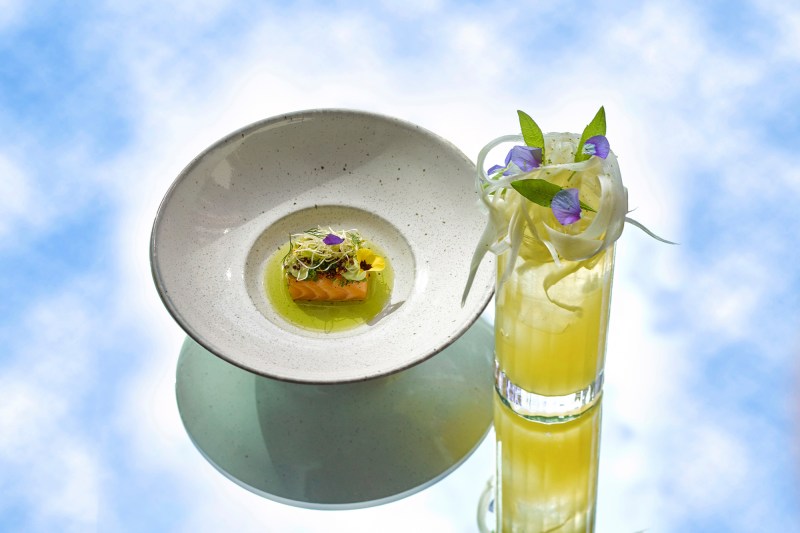When we initially decided to explore this trendy topic, we asked some expert sources questions about “closed-loop” cocktails (a phrase that you will see and hear often as sustainable cocktails continue to become increasingly popular). Drinkers and non-drinkers alike are becoming more conscious about their decision-making as it relates to the environment. Additionally, it’s a factor that many individuals weigh heavily before deciding on things like one shirt versus another — or, in this case, one cocktail versus another. You might just be one of these people — but when it comes to the concept of the “closed-loop,” it’s not so straightforward.

“I try to avoid this term when talking about cocktails,” Brooke Toscano, managing partner at Pouring Ribbons and an advocate of sustainability in bars, says. “A closed-loop cocktail, to me, seems rather unlikely in the sea of ‘sustainable’ cocktail menus out there. When you reuse or repurpose your waste you will typically still be left with a lot of packaging that is getting set out to be recycled. Most aren’t thinking about how likely it is that their recycled goods actually get recycled. Then you have the environmental impact of your item and deliveries. It’s a rather complicated loop so to say something is closed loop in the cocktail world, seems more complicated.”
Toscano makes a valid point and she sheds light on an area of sustainability that most people neglect to recognize: The carbon footprint of both transportation and packaging. Packaging is often the trickiest one to navigate, but it is possible to upcycle depending on the good. As for mitigating the carbon footprint of excessive transportation of goods, many bars are taking to local foraging as a solution — if it’s feasible. All of this said, Toscano really hammers on the importance of thinking of sustainability from top to bottom, going all the way back to the origin of the ingredient, or product, and making sure we are coming at it from a holistic point of view as opposed to looking at sustainability in a vacuum. This leads us to hashing out what a low-waste, not closed-loop, cocktail really looks like, and where the best place to start is.
“One of the easiest places to start your low-waste cocktail journey is citrus,” Toscano says. “It’s generally traveling the farthest distance to get to us and we use so much of it. There are so many techniques to stretch the life of your citrus, Trash Tiki is a wonderful reference.”
“Water/ice would be my next move. It’s easy to control without buying new things or learning new techniques.” Vinny Starble, bar manager at Bad Hunter in Chicago, echoes Toscano’s beliefs about citrus being the best place to start when it comes to taking that step toward low waste, “I think the most wasted product in bars is citrus,” Starble says. “Citrus can potentially have 3-4 utilizations if treated properly. So for me, the best place to start is to make sure you’re not just using citrus for one thing. Peel it before juicing for an oleo saccharum or to make an oil with, use the hulls after juicing to make a stock or a tisane, use citrus cut for service to make cordials, etc. … if you extract juice from a vegetable, save the pulp, if you make a compound syrup, save the solids. Practicing saving things that are normally tossed and revisiting them later when you have a clearer mind is an excellent practice in training the brain to think about those things we considered as waste as unique products and flavors in their own right.”

Water — a commodity that most of us take for granted — is one of the most common places where we see waste in bars. White Lyan, a London-based bar concept that opened in 2013 but has since closed, really started the conversation around the reduction of water usage by eliminating ice from their beverage program, as well as fresh citrus (crazy, I know.). Pre-diluting cocktails with precise measurements and bottling them for service removes the need to shake with ice to achieve both the ideal water content and temperature for cocktails — a feat that White Lyan boasted of during its tenure.
Lorenzo Sgattone, Assistant Bar Manager at Bluespoon Bar at Andaz Amsterdam Prinsengracht, explains how its beverage program tries to incorporate whole utilization (essentially this nose-to-tail concept) wherever possible as a way to be less wasteful. “One of our new bestsellers is the “Curiouser & Curiouser,” [which is] based with carrots,” he says. “The carrots are first grilled and then infused with gin, after, with the same carrot we make the syrup, and with what is left from it, we make carrot chips that will be the garnish of the drinks. This way we make maximum use of one ingredient from nose-to-tail!”
Sgattone says that Bluespoon Bar has, historically, also used spent coffee granules to create a take on the Espresso Martini, and often gets creative with leftover ingredients, for example: Lemon and orange peels, to create a lemon & orange sherbet (essentially an oleo saccharum of sorts — an easy ingredient to make at home or at your bar). Sgattone isn’t the only one who played around with carrot-flavored cocktails with Starble and the Bad Hunter team taking a similar approach to eliminate waste of this abundant vegetable. “[For the Carrot Cooler 3.1] we wanted to get a roasted carrot profile throughout the drink,” Starble says. “To do this we roast carrots and cook them into a sugar syrup. We then take those carrots and infuse them into blanco tequila. For this we’ve cut our waste down by half for how many carrots we would use and also achieve a beautiful note of the carrots that have been roasted and cooked in a water bath, which deepens the profile of the drink as a whole.”

At Pouring Ribbons, Toscano and team ensure that at least one component of every cocktail on their menu incorporates a reused, trash, or low-waste element. “Some are more complicated while others are seemingly simple,” she says. “[For example,] Black pepper honey: We steep the black peppercorns in water as a tea. We then blend the peppercorn water with a local honey to produce the syrup. We take the leftover black peppercorns and dehydrate them then grind them in a spice grinder. We add this powder to a sugar, salt, bee pollen rim for the same cocktail.”
Low-waste can manifest in a variety of ways as you can tell from some of the examples given, but it really all starts with education for both bar staffs and consumers alike. “It is important for the general public to be aware of more sustainable options, and understand how their decisions can shape the environment,” Mr. Yuichi Shirao, bartender at the Rooftop Bar at Andaz Tokyo, says. “By changing from plastic to paper straws, customers immediately understand the conscious choice that we at the Rooftop Bar are making, and how customers themselves can choose more sustainable options for cocktails and beyond.” Toscano also shares this sentiment. “Low waste cocktails are important especially when properly conveyed to the guest because they can empower them,” she says. “You’re giving them that feel-good moment that can translate into their own lives. Showing these things don’t take a tremendous amount of work is also key because just that little spark of ‘oh I didn’t think of it like that’ is all it takes sometimes.”



